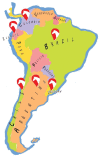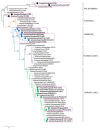An Overview of Equine Influenza in South America
- PMID: 34065839
- PMCID: PMC8151294
- DOI: 10.3390/v13050888
An Overview of Equine Influenza in South America
Abstract
Equine influenza virus (EIV) is one of the most important respiratory pathogens of horses as outbreaks of the disease lead to significant economic losses worldwide. In this review, we summarize the information available on equine influenza (EI) in South America. In the region, the major events of EI occurred almost in the same period in the different countries, and the EIV isolated showed high genetic identity at the hemagglutinin gene level. It is highly likely that the continuous movement of horses, some of them subclinically infected, among South American countries, facilitated the spread of the virus. Although EI vaccination is mandatory for mobile or congregates equine populations in the region, EI outbreaks continuously threaten the equine industry. Vaccine breakdown could be related to the fact that many of the commercial vaccines available in the region contain out-of-date EIV strains, and some of them even lack reliable information about immunogenicity and efficacy. This review highlights the importance of disease surveillance and reinforces the need to harmonize quarantine and biosecurity protocols, and encourage vaccine manufacturer companies to carry out quality control procedures and update the EIV strains in their products.
Keywords: H3N8; H7N7; South America; equine influenza.
Conflict of interest statement
The authors declare no conflict of interest.
Figures


Similar articles
-
Characterisation of the epidemic strain of H3N8 equine influenza virus responsible for outbreaks in South America in 2012.Virol J. 2016 Mar 19;13:45. doi: 10.1186/s12985-016-0503-9. Virol J. 2016. PMID: 26993620 Free PMC article.
-
Equine Influenza Virus and Vaccines.Viruses. 2021 Aug 20;13(8):1657. doi: 10.3390/v13081657. Viruses. 2021. PMID: 34452521 Free PMC article. Review.
-
Equine Influenza Virus in Asia: Phylogeographic Pattern and Molecular Features Reveal Circulation of an Autochthonous Lineage.J Virol. 2019 Jun 14;93(13):e00116-19. doi: 10.1128/JVI.00116-19. Print 2019 Jul 1. J Virol. 2019. PMID: 31019053 Free PMC article.
-
Continuing evolution of equine influenza virus in Central Asia, 2007-2012.Arch Virol. 2014 Sep;159(9):2321-7. doi: 10.1007/s00705-014-2078-3. Epub 2014 Apr 20. Arch Virol. 2014. PMID: 24748052
-
A Brief Introduction to Equine Influenza and Equine Influenza Viruses.Methods Mol Biol. 2020;2123:355-360. doi: 10.1007/978-1-0716-0346-8_26. Methods Mol Biol. 2020. PMID: 32170701 Review.
Cited by
-
First Molecular Detection and Epidemiological Analysis of Equine Influenza Virus in Two Regions of Colombia, 2020-2023.Viruses. 2024 May 24;16(6):839. doi: 10.3390/v16060839. Viruses. 2024. PMID: 38932133 Free PMC article.
-
Seroprevalence of Equine Influenza Virus Antibodies in Horses from Four Localities in Colombia.Viruses. 2025 Jul 16;17(7):999. doi: 10.3390/v17070999. Viruses. 2025. PMID: 40733615 Free PMC article.
-
Comparative evolution of influenza A virus H1 and H3 head and stalk domains across host species.mBio. 2024 Jan 16;15(1):e0264923. doi: 10.1128/mbio.02649-23. Epub 2023 Dec 11. mBio. 2024. PMID: 38078770 Free PMC article.
-
Understanding the divergent evolution and epidemiology of H3N8 influenza viruses in dogs and horses.Virus Evol. 2023 Aug 18;9(2):vead052. doi: 10.1093/ve/vead052. eCollection 2023. Virus Evol. 2023. PMID: 37692894 Free PMC article.
-
Frequency of Detection and Prevalence Factors Associated with Common Respiratory Pathogens in Equids with Acute Onset of Fever and/or Respiratory Signs (2008-2021).Pathogens. 2022 Jul 2;11(7):759. doi: 10.3390/pathogens11070759. Pathogens. 2022. PMID: 35890002 Free PMC article.
References
-
- Cullinane A., Gahan J., Walsh C., Nemoto M., Entenfellner J., Olguin-Perglione C., Garvey M., Huang Fu T.Q., Venner M., Yamanaka T., et al. Evaluation of Current Equine Influenza Vaccination Protocols Prior to Shipment, Guided by OIE Standards. Vaccines. 2020;8:107. doi: 10.3390/vaccines8010107. - DOI - PMC - PubMed
Publication types
MeSH terms
Substances
LinkOut - more resources
Full Text Sources

